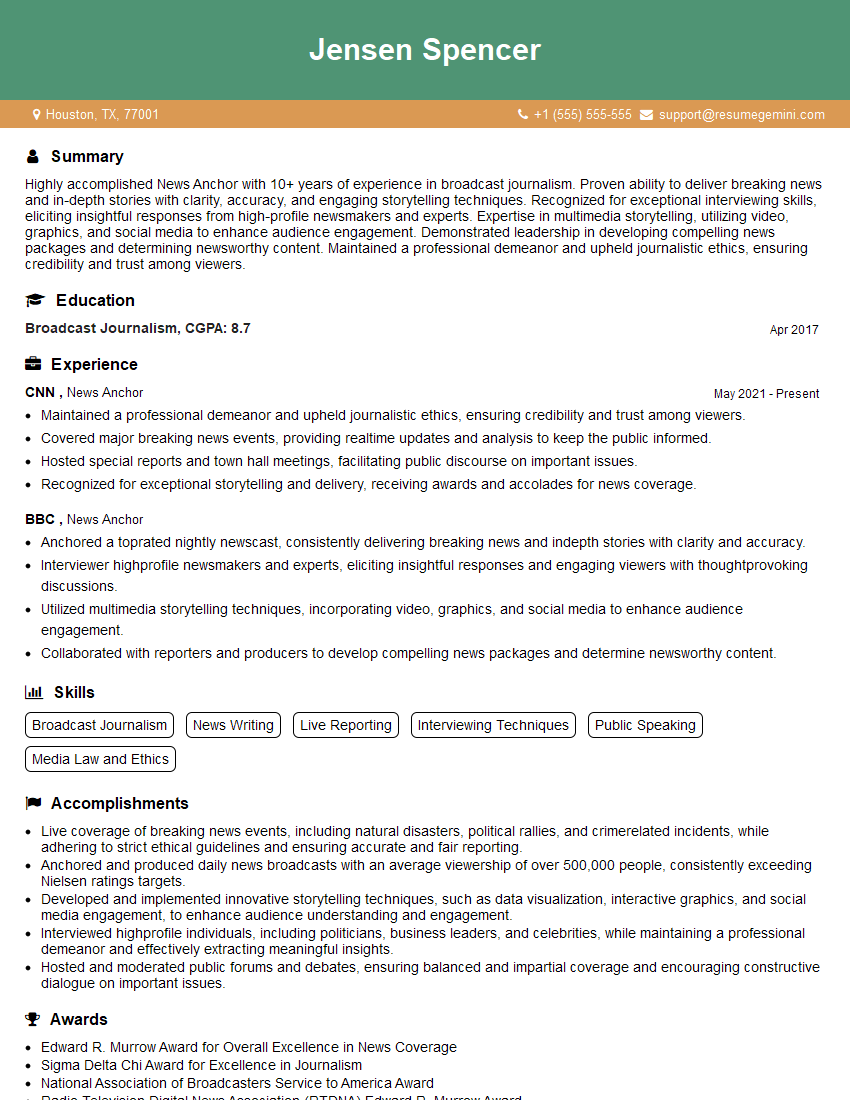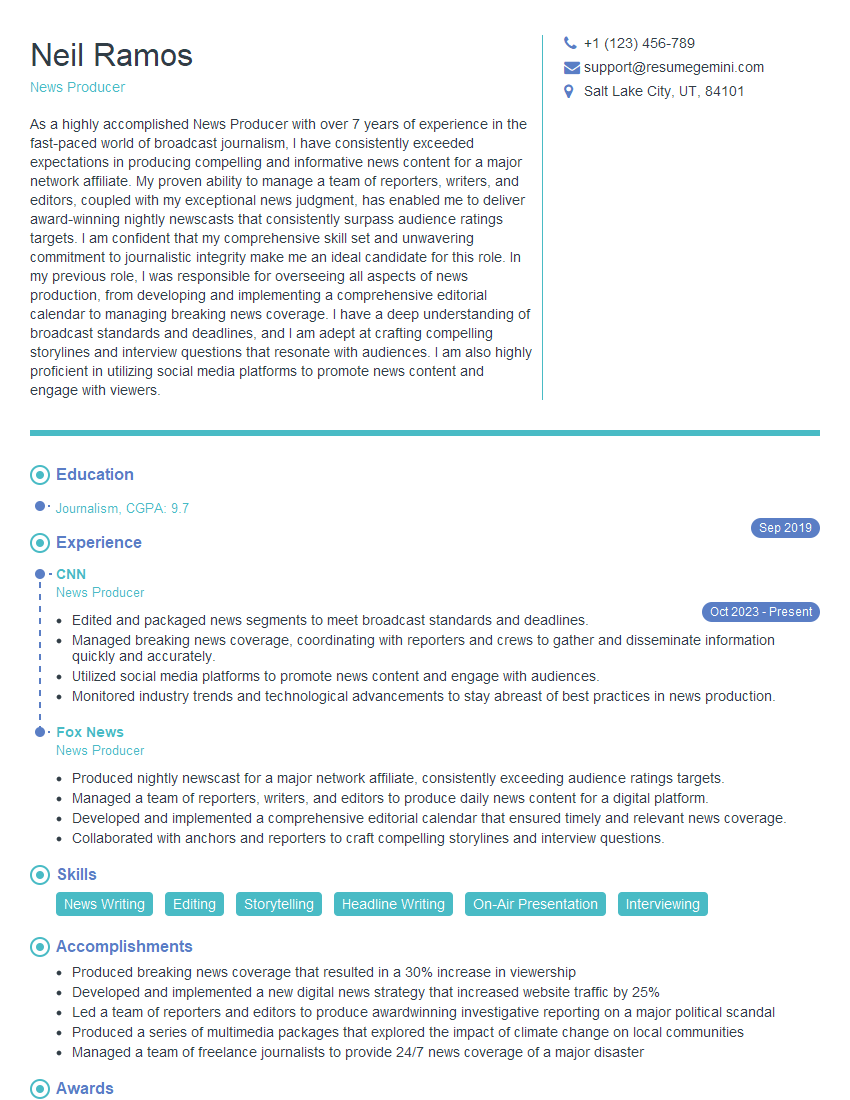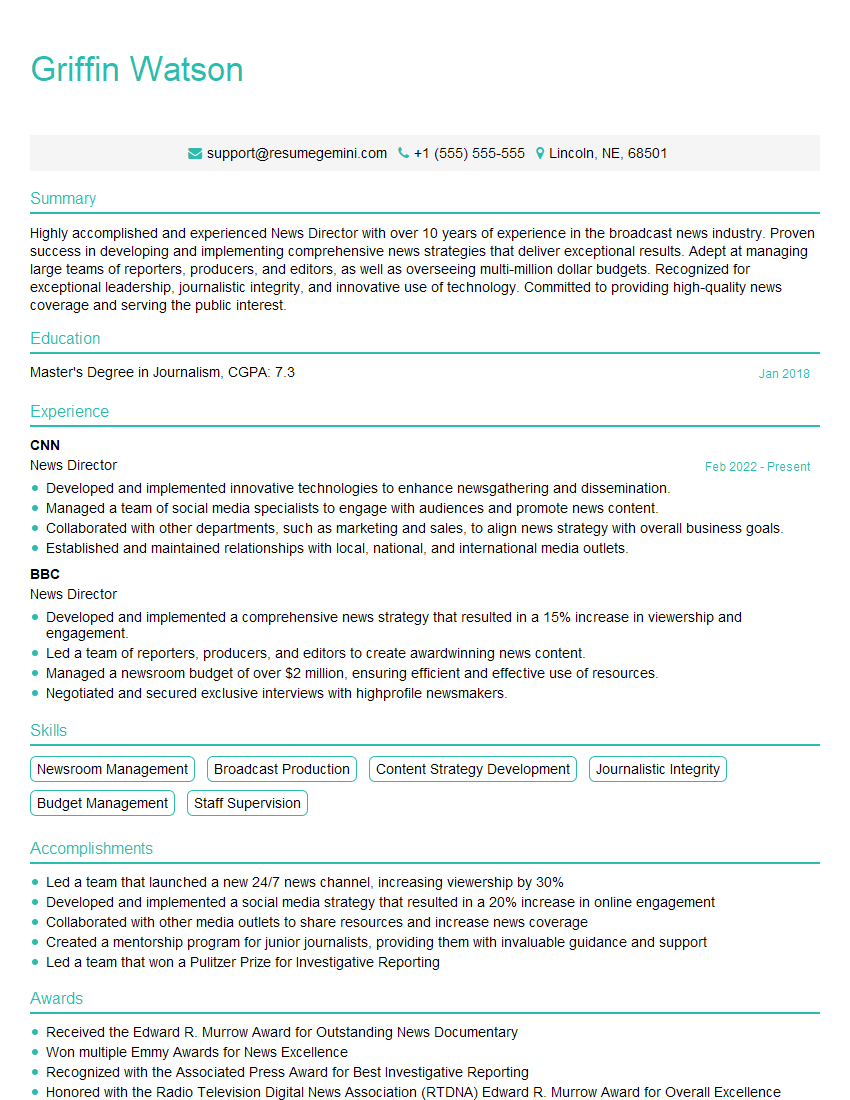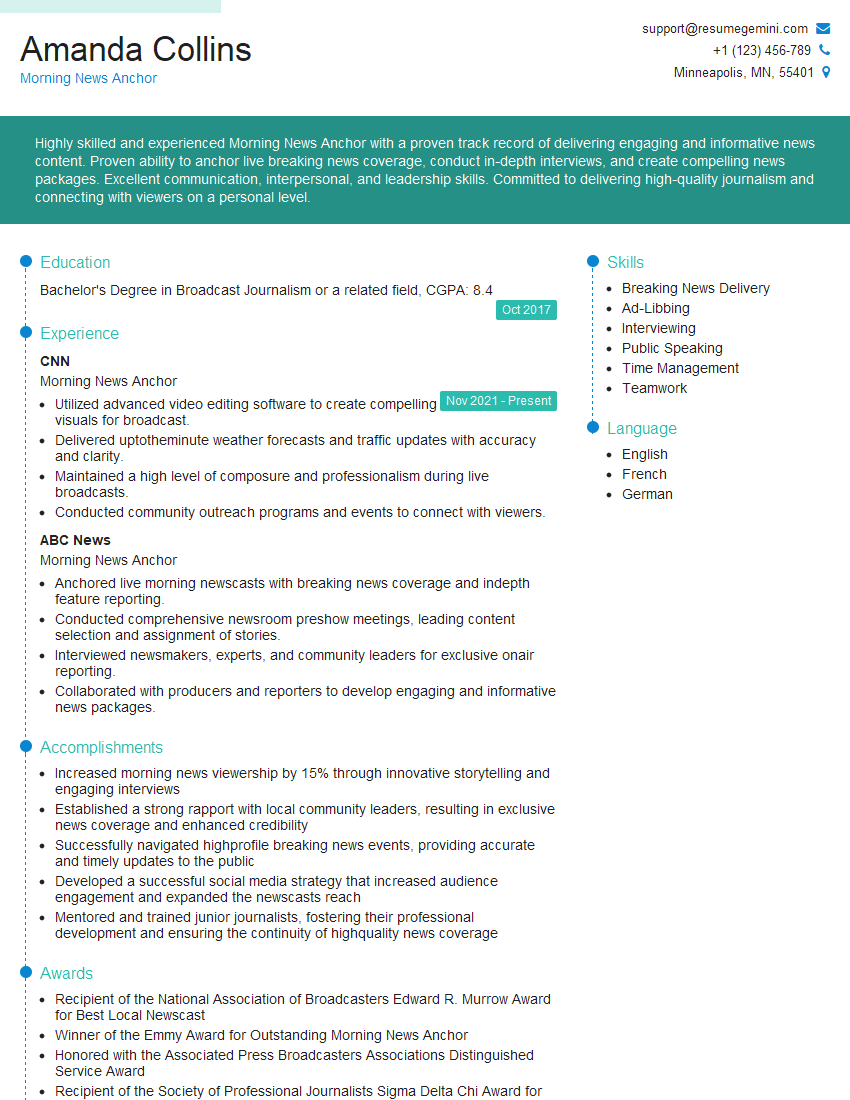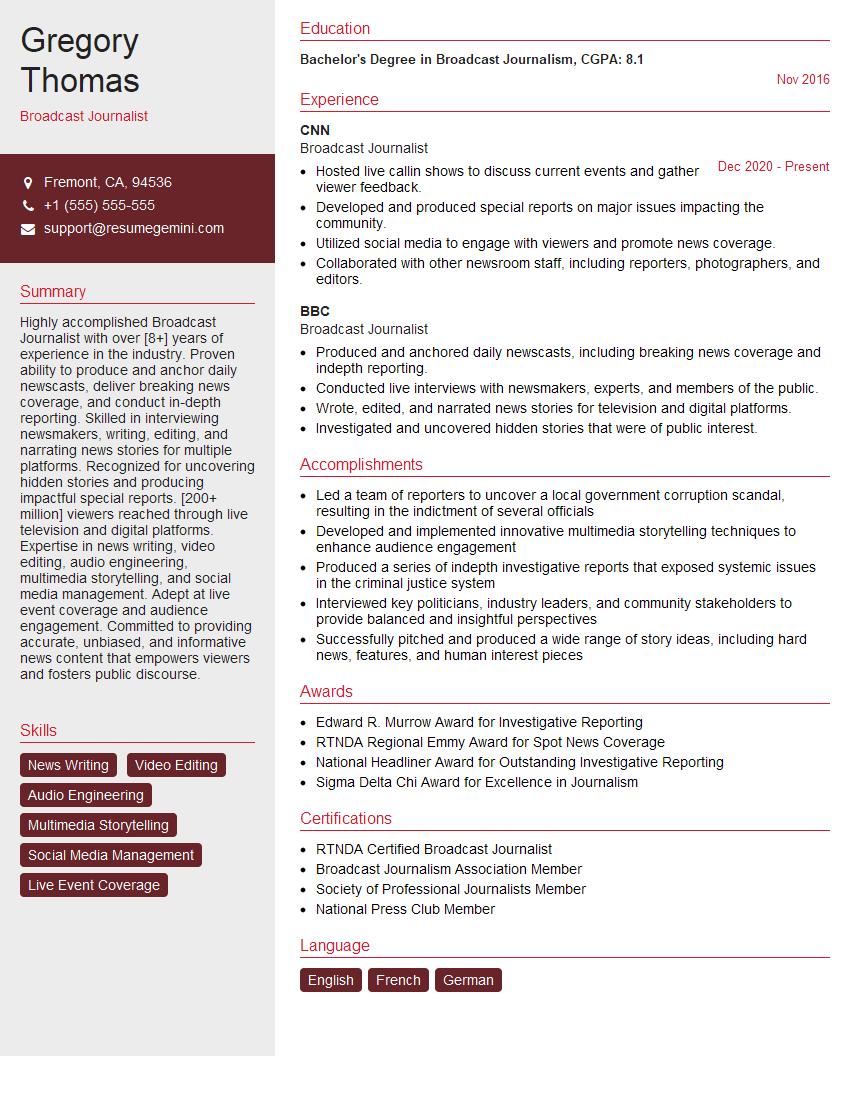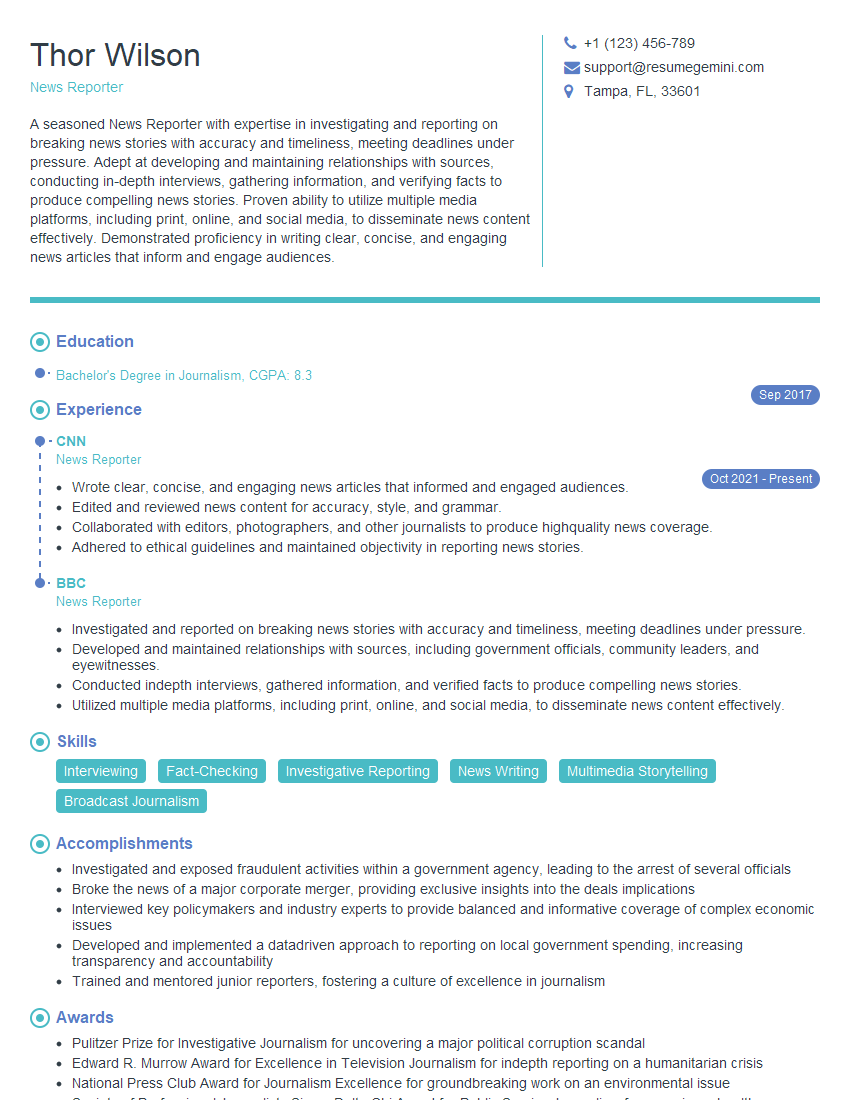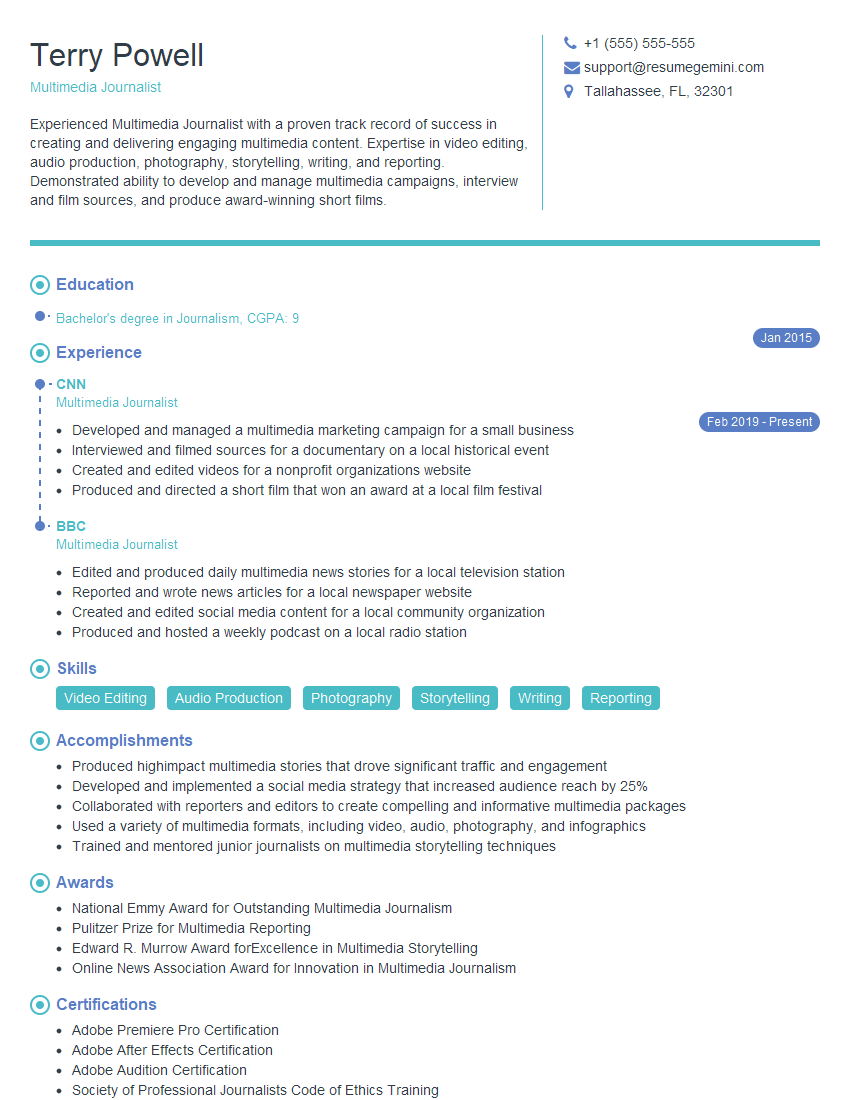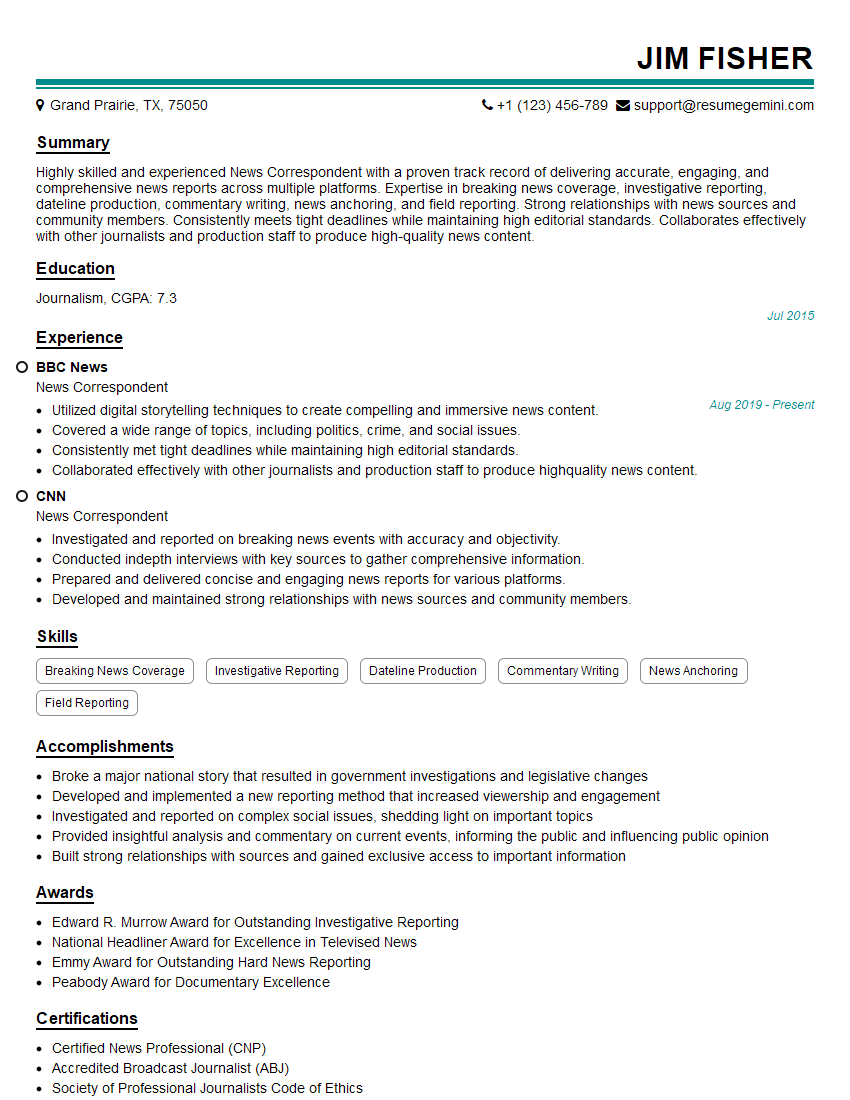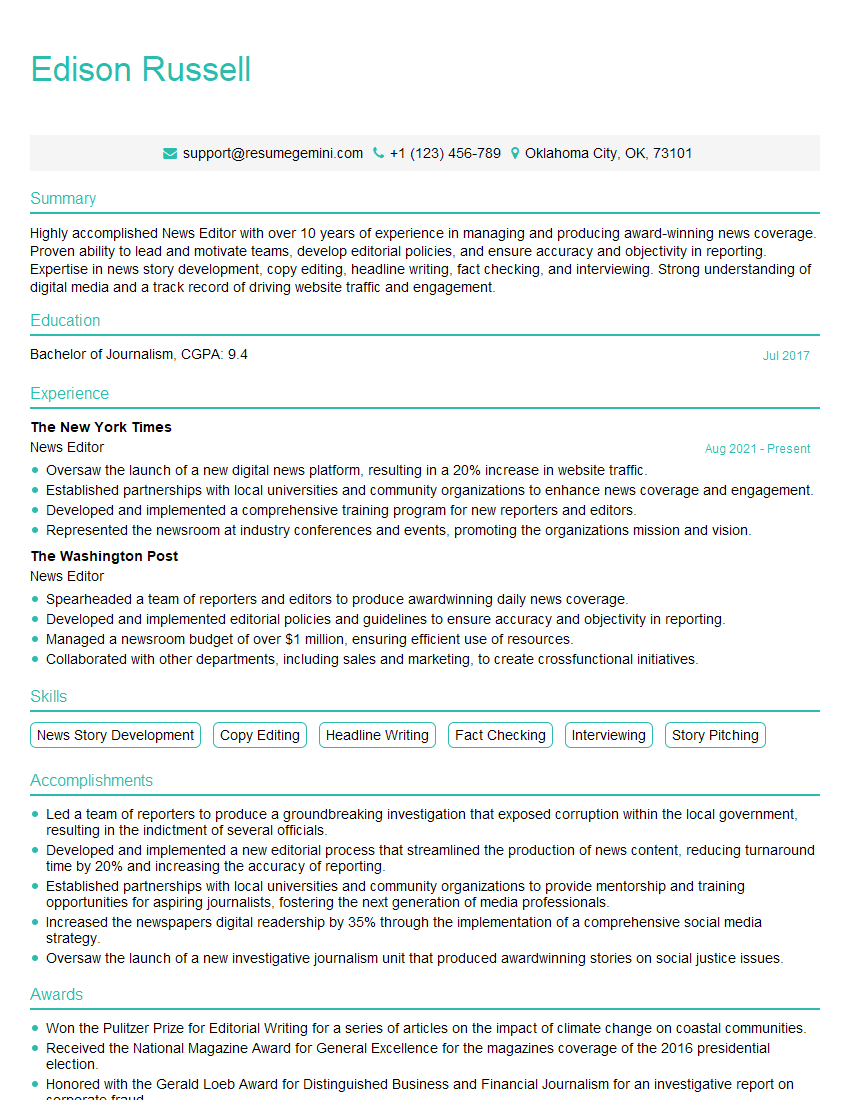Warning: search_filter(): Argument #2 ($wp_query) must be passed by reference, value given in /home/u951807797/domains/techskills.interviewgemini.com/public_html/wp-includes/class-wp-hook.php on line 324
Feeling uncertain about what to expect in your upcoming interview? We’ve got you covered! This blog highlights the most important News Reading interview questions and provides actionable advice to help you stand out as the ideal candidate. Let’s pave the way for your success.
Questions Asked in News Reading Interview
Q 1. Explain your experience with teleprompter use.
My experience with teleprompters is extensive. I’m proficient in using them at various speeds and maintaining eye contact with the camera, even while reading complex material. I’ve worked with both traditional scrolling teleprompters and software-based solutions. I understand the importance of pacing and rhythm to ensure a natural delivery, even when reading from a script. For example, during my time at Channel 7 News, I regularly used a dual-screen teleprompter setup for live broadcasts, achieving an average reading speed of 150 words per minute while maintaining engaging visual contact with the viewer. I’ve also adapted my technique to different teleprompter styles, including those with adjustable font sizes, speeds, and color schemes. My experience isn’t just about technical proficiency, but also about adapting my reading style to the specific demands of the teleprompter and the overall broadcast aesthetic.
Q 2. Describe your approach to reading news scripts accurately and expressively.
Accurately and expressively reading news scripts involves a multi-faceted approach. First, I thoroughly prepare by carefully reviewing the script multiple times, noting pronunciation challenges and areas that require emphasis. I look for natural pauses and inflections to avoid monotone delivery. Then, I focus on understanding the context and emotional tone of each sentence, which informs my vocal delivery. For instance, a story about a natural disaster would demand a more somber tone compared to a piece on local achievements. I practice the script aloud, refining my pacing and emphasizing key words and phrases to convey the message effectively. Think of it like acting – you need to understand and embody the story to convey it authentically. My goal is never just to read the words, but to communicate the story with clarity, precision, and emotional impact.
Q 3. How do you handle unexpected interruptions or breaking news during a live broadcast?
Handling unexpected interruptions or breaking news during a live broadcast requires quick thinking and adaptability. My training emphasizes maintaining composure while swiftly assessing the situation. If a breaking news alert interrupts, I smoothly transition into the new information, using pre-planned cues and concise language to inform viewers. I’ve found that a calm and confident demeanor reassures the audience. During one live broadcast, a major earthquake struck while I was reporting a local story. I paused briefly, acknowledged the situation, and then seamlessly transitioned to live coverage of the earthquake, drawing on my knowledge of emergency reporting procedures. The key is to stay informed, react quickly, and communicate clearly while adapting to the unexpected.
Q 4. How do you maintain composure and professionalism under pressure?
Maintaining composure and professionalism under pressure is paramount in news broadcasting. Years of experience have equipped me with the ability to manage stress effectively. This includes thorough preparation, a deep understanding of the material, and the ability to focus on the task at hand. Mental exercises like deep breathing and mindfulness techniques help me remain calm and centered, even in high-pressure situations. Furthermore, a strong sense of self-awareness helps me recognize when I might be losing my composure and take necessary steps to regain control. Think of it like a tightrope walker – consistent training and focus are key to success, even when facing unexpected challenges.
Q 5. Describe your experience with voice modulation and inflection.
Voice modulation and inflection are critical for engaging storytelling. I’ve developed a broad range of vocal techniques to match the tone and content of various news stories. I can easily adjust my pace, volume, and pitch to create emphasis, convey emotion, and keep the audience interested. For example, a light and conversational tone might be appropriate for a human-interest piece, whereas a more formal and serious tone would suit a report on political developments. I regularly work with vocal coaches to refine my skills and enhance my vocal versatility. This isn’t just about sounding good; it’s about effectively communicating meaning and emotion to the audience.
Q 6. How familiar are you with various news writing styles (e.g., AP style)?
I’m very familiar with various news writing styles, including AP style. I understand the importance of accuracy, conciseness, and objectivity in news reporting. AP style, for example, provides a consistent framework for grammar, punctuation, and style that ensures clarity and professionalism. My experience encompasses various news styles, from the concise and factual reporting typical of AP to the more narrative-driven style often found in feature pieces. I’m adept at adapting my delivery to complement the chosen writing style, ensuring the story’s impact is maximized. I regularly review style guides to maintain accuracy and consistency in my work.
Q 7. How do you prioritize information for delivery in a time-constrained news segment?
Prioritizing information in a time-constrained news segment requires a clear understanding of the story’s most crucial elements. My approach involves identifying the ‘who, what, when, where, why, and how’ – the core elements of any news story. I focus on delivering the most significant facts first, ensuring the audience gets the key information even if the segment is cut short. I also consider the audience’s potential prior knowledge and tailor the information accordingly. Think of it like building a pyramid – the most essential information forms the base, with less crucial details layered on top. This way, even if the segment is truncated, the audience still receives the essential information.
Q 8. Explain your understanding of news ethics and journalistic integrity.
News ethics and journalistic integrity are the cornerstones of credible reporting. They represent a commitment to truth, accuracy, fairness, and independence. It’s about upholding the public’s trust by ensuring the information disseminated is factual, unbiased, and presented responsibly.
- Accuracy: Verifying information from multiple sources, fact-checking claims rigorously, and correcting errors promptly are essential. Failing to do so can lead to misinformation and damage to the news organization’s reputation. For example, before reporting on a significant event like a natural disaster, we’d confirm the casualty numbers and damage extent through official channels and reputable sources, avoiding unsubstantiated social media reports.
- Fairness and Impartiality: Presenting all sides of a story, offering diverse perspectives, and avoiding biased language are vital. We strive for objectivity, even when dealing with contentious issues. For instance, in a political news report, I ensure to present both candidates’ platforms and policies without favoring one over the other.
- Independence: Maintaining editorial independence from external pressures, including advertisers, political entities, or personal biases, is paramount. This involves disclosing any conflicts of interest and resisting attempts to influence news coverage.
- Accountability: Taking responsibility for errors, providing corrections and clarifications when necessary, and adhering to a clear code of ethics demonstrates accountability and fosters public trust.
Q 9. How do you adapt your delivery for different news stories (e.g., serious vs. lighthearted)?
Adapting my delivery depends heavily on the story’s tone and subject matter. A serious news story, like a natural disaster or political crisis, demands a somber, respectful, and informative approach. My voice would be measured, my language precise, and my delivery empathetic.
Conversely, a lighthearted story, such as a local community event or a heartwarming human-interest piece, allows for a more relaxed and engaging tone. I might use a slightly more conversational style, perhaps incorporate a touch of humor (appropriate to the context), and focus on the positive aspects of the story.
The key is to maintain professionalism while adapting to the story’s inherent nature. Think of it like acting – you wouldn’t deliver a Shakespearean monologue with the same energy as a comedic skit.
Q 10. How would you handle a technical malfunction during a live broadcast?
Handling a technical malfunction during a live broadcast requires quick thinking and professionalism. My immediate response would depend on the nature of the problem. If it’s a minor issue like a dropped audio connection, I might smoothly transition to a pre-prepared segment or simply pause briefly while the technical team resolves the issue. I’d maintain a calm demeanor, assuring viewers that everything is being addressed.
For more significant problems, such as a complete system failure, my training kicks in. I’d follow established emergency protocols – this could involve switching to a backup feed, communicating calmly with the studio, or apologizing to the viewers for the interruption while remaining composed and professional. The goal is to minimize disruption and maintain credibility, even under pressure. Experience has taught me to remain flexible and adapt to unexpected situations with grace.
Q 11. Describe your experience with improvisation and ad-libbing in news delivery.
Improvisation and ad-libbing are essential skills for a news anchor. While preparation is key, unexpected situations often arise. I’ve honed my ability to seamlessly transition between prepared scripts and spontaneous remarks. This might involve filling dead air time during a technical glitch, gracefully correcting an error in the teleprompter, or responding naturally to a surprising guest comment.
My approach involves having a strong grasp of the subject matter, maintaining a calm and confident presence, and thinking on my feet. I draw upon my knowledge and experience to formulate appropriate responses, ensuring the flow of the broadcast remains smooth and coherent. For example, if a guest unexpectedly makes a controversial statement, I might smoothly redirect the conversation, asking a follow-up question to steer the discussion back on track while still allowing the guest to express their views.
Q 12. How do you prepare for a live broadcast?
Preparation for a live broadcast is meticulous and multi-faceted. It begins with thoroughly reviewing the script and understanding the content. This involves not just reading the words but also internalizing the information to ensure confident and natural delivery.
- Script Review: I carefully go through the script, noting any challenging pronunciations or complex concepts requiring further clarification.
- Research: I might conduct additional research to deepen my understanding of the subject matter, especially if it involves technical or specialized topics.
- Rehearsal: I practice the delivery multiple times, focusing on pacing, intonation, and body language. I also utilize the teleprompter to familiarize myself with the technology and its speed.
- Wardrobe Check: I carefully consider my attire to ensure it is appropriate for the news program’s tone and style.
- Technical Check: I make sure all equipment, including microphones and cameras, are functioning correctly.
- Mental Preparation: I focus on maintaining composure, managing stress, and keeping a clear mind. A calming breathing exercise is crucial in ensuring a confident performance.
Q 13. What is your approach to understanding complex topics quickly and accurately?
Understanding complex topics rapidly and accurately relies on a structured approach. I use a combination of efficient reading techniques, strategic note-taking, and cross-referencing information from multiple reliable sources.
- Skimming and Scanning: I first skim the material to get a general overview. Then I scan for key information, focusing on headings, subheadings, and bolded terms.
- Note-Taking: I summarize key points in my own words, creating concise notes that aid comprehension and retention.
- Cross-Referencing: I consult several sources to verify the information and ensure a balanced perspective. A single source might be biased, whereas multiple sources strengthen the accuracy of my understanding.
- Visual Aids: When applicable, I utilize charts, diagrams, or other visuals to grasp complex relationships and data effectively.
- Questioning: If something remains unclear, I formulate questions to further investigate the topic.
Q 14. How do you research and verify information for accuracy in news reports?
Research and verification are non-negotiable for accurate news reporting. My approach is rigorous and multi-layered. It begins with identifying reliable sources – this includes government agencies, academic institutions, reputable news organizations, and subject-matter experts. I avoid relying solely on unverified social media posts or anonymous sources.
- Source Verification: I check the credibility of each source, considering its reputation, potential biases, and track record.
- Fact-Checking: I meticulously cross-check information against multiple sources, looking for inconsistencies or contradictions. I use fact-checking websites and databases to verify claims.
- Multiple Perspectives: I actively seek diverse viewpoints to ensure a balanced and comprehensive understanding of the story.
- Contextualization: I place information within its proper historical and social context to avoid misinterpretations.
- Attribution: I clearly attribute information to its source, allowing readers to trace the origin of the facts presented.
For example, before reporting on a scientific study, I would not only read the study itself but also seek expert opinions to ensure its findings are properly interpreted and placed within the wider scientific context. Furthermore, I would check whether the study has been peer-reviewed and published in a reputable journal.
Q 15. Explain your experience working with reporters and producers.
My experience collaborating with reporters and producers has been extensive and multifaceted. It involves a strong understanding of teamwork and collaborative communication. I’ve worked closely with reporters to refine scripts, ensuring accuracy, clarity, and a compelling narrative. This includes offering feedback on pacing, tone, and the overall impact of the story. With producers, I’ve been actively involved in pre-broadcast planning, discussing segment order, timing, and visual elements to create a cohesive newscast. For instance, I worked with a producer on a breaking news story about a major storm. Together, we adjusted the script and graphics in real-time to reflect the rapidly changing situation, ensuring viewers received timely and accurate information. I also participate in story selection discussions to offer insights into what might resonate most effectively with our audience.
Career Expert Tips:
- Ace those interviews! Prepare effectively by reviewing the Top 50 Most Common Interview Questions on ResumeGemini.
- Navigate your job search with confidence! Explore a wide range of Career Tips on ResumeGemini. Learn about common challenges and recommendations to overcome them.
- Craft the perfect resume! Master the Art of Resume Writing with ResumeGemini’s guide. Showcase your unique qualifications and achievements effectively.
- Don’t miss out on holiday savings! Build your dream resume with ResumeGemini’s ATS optimized templates.
Q 16. Describe your experience with different types of news delivery (e.g., solo, with guests).
I’m comfortable presenting news in various formats. Solo anchoring provides a focused presentation style, allowing me to control the pace and tone. I can adapt my delivery to suit the gravity of the news; a light-hearted approach for lighter stories, a more solemn one for tragedies. Working with guests offers a dynamic alternative. It requires excellent active listening skills and the ability to guide the conversation while ensuring a smooth flow of information. For example, I recently interviewed a leading economist on the latest inflation figures. This required carefully constructed questions and the ability to summarise complex economic data for a broader audience, while maintaining a respectful and engaging dialogue. I believe the ability to seamlessly transition between these formats enhances my versatility as a news anchor.
Q 17. How do you manage stage presence and maintain viewer engagement?
Maintaining viewer engagement is paramount. My stage presence focuses on confident yet approachable delivery. I believe in making eye contact with the camera – I envision viewers in my mind as I speak, creating a connection. Varying vocal tone and pace keeps the audience interested, avoiding monotony. Body language also plays a key role; gestures should be natural and purposeful, enhancing, rather than distracting from, the message. For example, during a segment on climate change, I incorporated meaningful visuals to highlight the seriousness of the issue, and paused for dramatic effect at key points in the narrative. To stay engaging, I consistently review audience feedback to identify areas for improvement, adapt my presentation style based on audience demographics and story type, and stay abreast of the latest news presentation techniques.
Q 18. How comfortable are you working with autocue/teleprompter?
I am highly proficient with autocue/teleprompters. My experience enables me to read smoothly and naturally, maintaining eye contact and avoiding a robotic delivery. I understand the importance of pacing and emphasis, and I can adapt my reading speed to accommodate complex or lengthy sentences. The key is to read ahead, anticipate pauses, and connect the information to build a fluent presentation. I can even smoothly improvise small corrections or additions if required, all while maintaining the natural flow of the broadcast. Regular practice and familiarity with the technology have been vital in developing this skill, which is crucial for delivering high-quality news reports under pressure.
Q 19. How would you respond to a difficult or controversial question from a viewer?
Responding to difficult or controversial questions requires a calm, professional approach. My strategy involves acknowledging the question, restating it for clarity, and then providing a balanced and informed response. I avoid being defensive or dismissive. I will emphasize facts and credible sources, while acknowledging any differing viewpoints that exist. If I don’t have immediate knowledge of the topic, I’ll state that I’ll follow up and provide an update in a future broadcast. For instance, if a viewer challenges a particular statistic, I would verify the source and either confirm or correct the information, explaining the process clearly. Maintaining neutrality and respectful dialogue is essential, aiming to inform and reassure the audience. Transparency is crucial in building and maintaining trust.
Q 20. Describe your experience in handling stressful situations in a broadcast environment.
The broadcast environment often presents stressful situations. I’ve handled last-minute script changes, technical difficulties, and breaking news announcements with composure. My approach emphasizes staying calm, focusing on the immediate task, and prioritizing clear communication with the team. For example, during a live broadcast, we experienced a sudden power outage. I calmly reassured the audience, explaining the situation and maintaining a professional demeanor until the issue was resolved. Regular practice and training sessions simulate real-world scenarios, building resilience and confidence in my ability to handle unexpected challenges effectively. Preparedness is key in these high-pressure moments. A calm and collected anchor can maintain the credibility of the broadcast, even during unprecedented circumstances.
Q 21. What are your strengths and weaknesses as a news reader?
My strengths include clear articulation, excellent pronunciation, a calm demeanor under pressure, and the ability to connect with the audience on a personal level. My versatility allows me to seamlessly transition between different news formats and adapt my style to meet the needs of the story. A weakness I am actively working on is improving my spontaneity even further; while I’m proficient in handling unexpected questions, continuously honing my improvisation skills will ensure even more natural and engaging broadcasts. I believe in continuous learning and self-improvement, constantly seeking ways to enhance my performance and become a more effective news reader.
Q 22. How familiar are you with different news formats and styles?
My familiarity with news formats and styles is extensive. I’ve worked with everything from concise, breaking news bulletins for television, requiring immediate impact and brevity, to in-depth, analytical pieces for print media, demanding thorough research and nuanced writing. I’m also proficient in digital formats, including social media posts, online news articles, and podcasts, each requiring a different tone and style. For example, a tweet needs to be immediate and impactful, using strong verbs and concise language, while a long-form article allows for greater detail and context. I understand the need to tailor the language and presentation to the specific medium and its audience.
- Breaking News (TV): Short, impactful sentences. Focus on the most crucial information first.
- In-depth articles (Print): Detailed explanations, supporting evidence, and different writing styles (e.g., narrative, analytical).
- Social Media Posts: Concise, engaging language, use of hashtags, and visual elements.
- Podcasts: Conversational tone, clear articulation, storytelling elements.
Q 23. How do you maintain accuracy and clarity while delivering news quickly?
Maintaining accuracy and clarity while delivering news quickly is paramount. My approach involves a multi-step process. First, I verify information from multiple reputable sources before reporting it. This involves cross-referencing facts, checking for biases, and confirming details with reliable sources. Then, I prioritize clarity by using simple language, avoiding jargon, and structuring the information logically. Visual aids, if applicable, can also help convey information quickly and clearly. For instance, during a live broadcast of a breaking event, I might use a map to show the location, avoiding complicated descriptions. Finally, I practice concise reporting, focusing on the essential details to avoid unnecessary complexity.
For example, if reporting on an accident, I wouldn’t say, ‘A vehicular incident occurred resulting in an estimated amount of property damage,’ but instead, ‘A car crash caused significant damage’.
Q 24. What is your approach to staying informed about current events?
Staying informed about current events is an ongoing process that requires a multi-faceted approach. I subscribe to several reputable news agencies, both international and national, ensuring diverse perspectives. I also actively monitor social media, but critically assess the sources, understanding the inherent biases and potential for misinformation. I attend press briefings and conferences whenever possible, and maintain networks of contacts within various fields to gain insider information and diverse viewpoints. Finally, I use news aggregators to efficiently scan headlines and major developments across multiple sources.
Q 25. Describe your experience working under deadlines.
My experience working under deadlines is extensive. In the fast-paced world of news, meeting deadlines is not just important, it’s essential. I’ve honed my time management skills to prioritize tasks, delegate effectively when possible, and work efficiently under pressure. I’m adept at quickly identifying the critical information, prioritizing it, and then writing and delivering it within the given timeframe. I’ve developed the ability to maintain composure and focus under stress, ensuring accuracy even when facing tight deadlines.
I recall one instance where I had to deliver a breaking news report within 30 minutes of receiving the information. Through focused effort and prioritization, I delivered a comprehensive and accurate report, which helped our organization maintain its credibility and responsiveness.
Q 26. How do you balance speed and accuracy in delivering news?
Balancing speed and accuracy is a constant challenge in news delivery. My strategy involves a rigorous fact-checking process, even while working against the clock. This often requires multiple sources and a keen eye for detail to ensure the accuracy of the information, even in a time-sensitive environment. I practice concise writing, avoiding unnecessary details that may slow down delivery without adding significant value. This is often achieved through careful planning and outlining the report before starting to write. It’s a delicate balance, but essential for maintaining journalistic integrity.
Q 27. How would you adapt your presentation to reach a specific target audience?
Adapting my presentation to reach a specific target audience is crucial. This involves understanding their demographics, interests, and preferred communication styles. For example, when presenting to a younger audience, I might use more informal language, incorporate visuals, and leverage social media platforms. When addressing a more professional audience, my language would be more formal, and I’d focus on data-driven insights and detailed analysis. Each audience requires a tailored approach to ensure the message is effectively conveyed and understood.
Q 28. What software or tools are you proficient in for news delivery?
I’m proficient in a range of software and tools essential for news delivery. This includes content management systems (CMS) like WordPress and Drupal for publishing online articles, video editing software like Adobe Premiere Pro and Final Cut Pro for producing video news reports, and social media management tools like Hootsuite and Buffer for disseminating information across different platforms. I’m also familiar with audio editing software like Audacity for podcast production, and various research databases and tools for verifying information and conducting thorough investigations. My proficiency extends to using newsroom communication systems for collaborative reporting.
Key Topics to Learn for News Reading Interview
- Vocal Delivery and Projection: Mastering vocal techniques like pace, tone, and inflection to effectively convey information and engage listeners. Practical application: Practice reading aloud news articles, paying close attention to your vocal nuances.
- Pronunciation and Diction: Ensuring clear and accurate pronunciation to maintain credibility and professionalism. Practical application: Identify and correct common mispronunciations, utilizing online pronunciation guides or working with a speech coach.
- Understanding and Interpreting News Copy: Grasping the core message and context of news articles quickly and accurately to deliver a concise and informative report. Practical application: Analyze different news styles and formats to understand the nuances of various types of reporting.
- Impromptu Reading and Adaptability: Developing the ability to read and understand new material quickly and adjust to unexpected changes or technical difficulties. Practical application: Practice reading news scripts without prior preparation and address potential on-air challenges with composure.
- Body Language and Presentation: Utilizing appropriate posture, eye contact, and gestures to enhance communication and build rapport with the audience. Practical application: Record yourself reading news and analyze your body language for improvements.
- News Judgement and Ethical Considerations: Understanding the importance of impartiality, accuracy, and responsible reporting in news delivery. Practical application: Analyze news articles for potential biases and consider ethical implications of different reporting approaches.
- Technical Proficiency (if applicable): Familiarity with teleprompters, studio equipment, and other relevant technologies. Practical application: Research and practice using teleprompters or similar technology to improve efficiency and professionalism.
Next Steps
Mastering news reading is crucial for career advancement in broadcasting and journalism. It opens doors to diverse roles and enhances your communication skills significantly. To maximize your job prospects, focus on crafting an ATS-friendly resume that highlights your key skills and experience. ResumeGemini is a trusted resource to help you build a compelling and effective resume tailored to the specific requirements of news reading positions. Examples of resumes tailored to News Reading are available below to guide you in creating your own.
Explore more articles
Users Rating of Our Blogs
Share Your Experience
We value your feedback! Please rate our content and share your thoughts (optional).
What Readers Say About Our Blog
Hi, I represent a social media marketing agency that creates 15 engaging posts per month for businesses like yours. Our clients typically see a 40-60% increase in followers and engagement for just $199/month. Would you be interested?”
Hi, I represent an SEO company that specialises in getting you AI citations and higher rankings on Google. I’d like to offer you a 100% free SEO audit for your website. Would you be interested?

